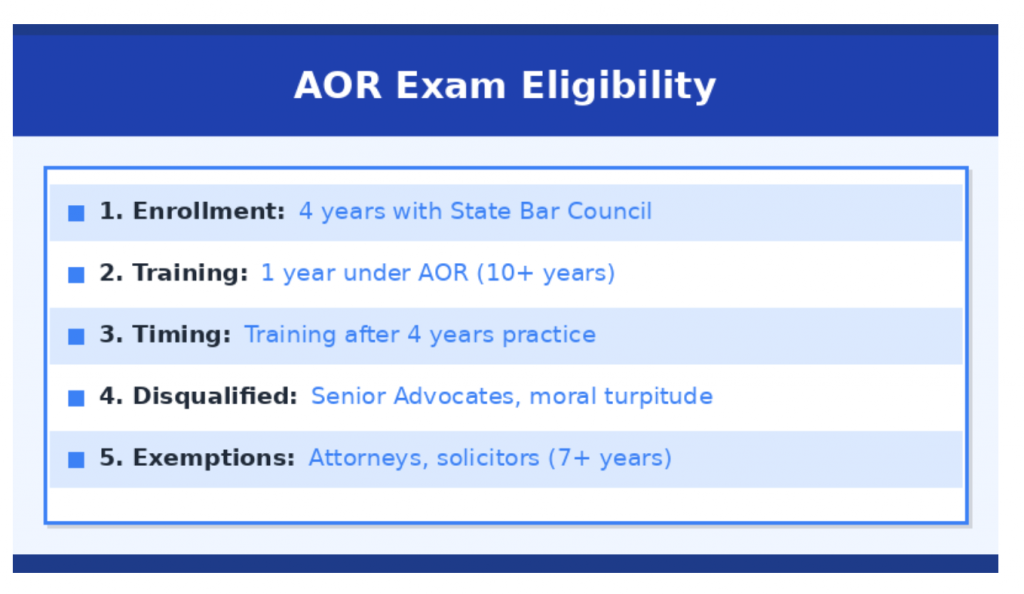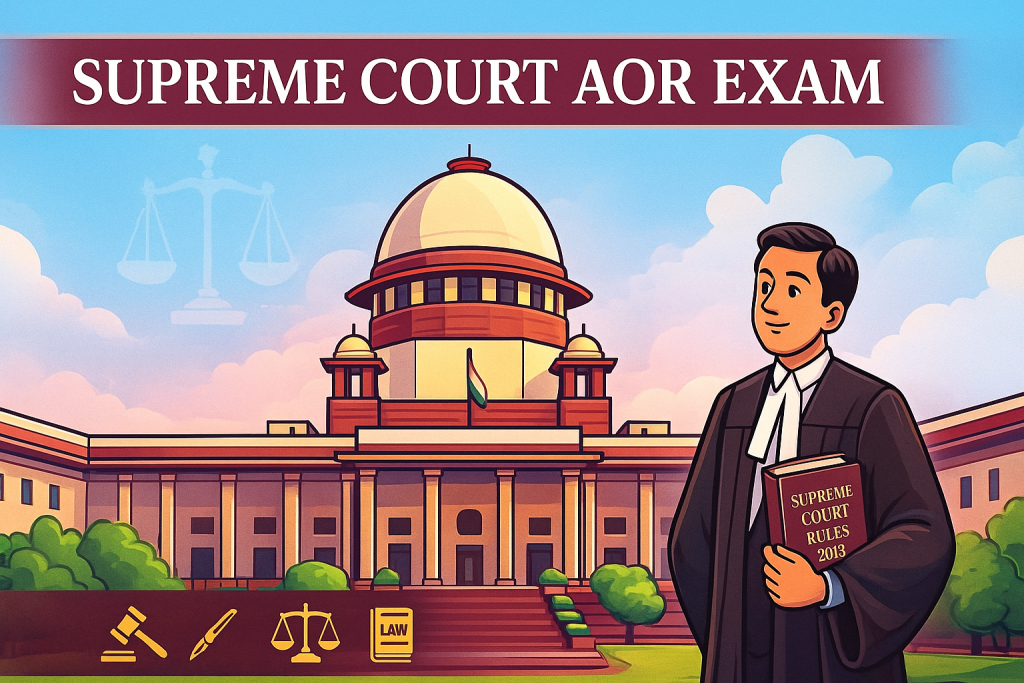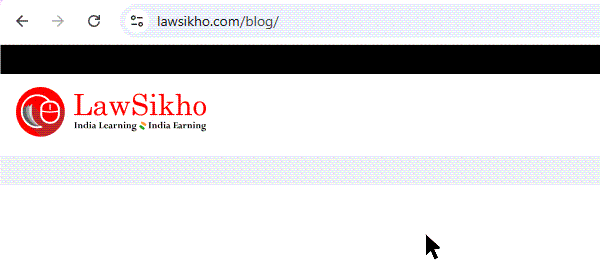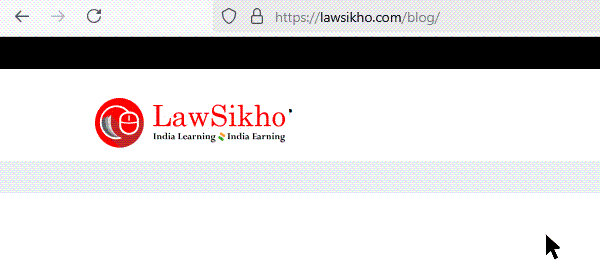This comprehensive guide explains everything about the Supreme Court AOR Exam eligibility rules, one year training requirements, application steps, syllabus, paper structure, marking criteria, and preparation strategies. With pass rates as low as 20–30% and only 3,789 AORs nationwide, the exam opens doors to exclusive Supreme Court practice and high-value career opportunities. Learn how to qualify, prepare effectively, and navigate the complete AOR journey with confidence.
Table of Contents
Imagine that you’re standing in the Supreme Court with your name now officially listed among the exclusive 3,789 advocates authorized to represent clients before the nation’s highest judicial authority.
Your professional stationery bears the coveted “AOR” designation. High-value clients who once seemed out of reach now seek your counsel, knowing you possess the rare qualification to take their most critical legal battles to the apex court.
Your annual income has jumped from lakhs to potentially crossing a crore as you establish your Supreme Court practice.
This isn’t a distant dream, it’s the reality awaiting advocates who successfully navigate the Supreme Court’s Advocate on Record (AOR) examination.
Today, I’ll walk you through everything you need to know about the Supreme Court AOR exam, from eligibility and application to preparation strategies and post exam procedures.
This comprehensive guide combines official Supreme Court regulations with practical insights to help you navigate your AOR journey successfully.
Why Become an Advocate on Record?
Lucrative Career Prospects in a Booming Legal Market
According to data from practicing AORs and Supreme Court practice analysis, a new AOR typically earns between ₹12,00,000 to ₹20,00,000 annually, assuming you’re actively building your practice.
Mid-career AORs with 10 years of practice comfortably earn ₹30-50 lakh annually. At this stage, you’ve built a referral network, established corporate client relationships, and your fees have increased substantially.
Senior AORs with 15+ years of practice and a strong reputation regularly cross ₹1 crore in annual income. Some top practitioners earn ₹2-3 crore or more, especially those with specialized practices in constitutional law, taxation, or corporate matters.
Exclusive Access to Supreme Court Practice and Prestige
Only an AOR can file petitions, vakalatnamas, and applications in the Supreme Court of India, this exclusive privilege is enshrined in Order IV of the Supreme Court Rules 2013.
Your AOR tag instantly elevates your professional standing across India, as you become part of an elite group of 3,789 advocates authorized to practice before the nation’s highest court.
Even if you continue practicing primarily in High Courts, your Supreme Court credentials inspire tremendous client confidence and open doors to high value, complex litigation.
Who is Eligible for the Supreme Court AOR Exam?

What are the Basic AOR Eligibility Requirements?
You need to meet three fundamental requirements to appear for the AOR exam.
First, you must have been enrolled with any State Bar Council in India for at least four years: this period is calculated from your enrollment date, not from passing the All India Bar Examination. Your name should be continuously on the Bar Council rolls without any disciplinary suspensions.
Second, you need one year of continuous training under an Advocate on Record who has at least 10 years of standing as an AOR. This training must commence only after completing your fourth year of practice. You’ll file a Commencement Certificate with the Supreme Court when you begin training, and a Completion Certificate before appearing for the exam.
Third, you must not be a Senior Advocate, and you cannot have been convicted of any offense involving moral turpitude. If you’ve been convicted, you’re ineligible for two years after completing your sentence or paying the fine. However, if the conviction is stayed or suspended by a court, this ineligibility doesn’t apply.
AOR Training Requirements: What You Need to Know
The one year training period is perhaps the most critical aspect of your AOR journey. You need to find an AOR with at least 10 years of standing who agrees to train you. This training is meant to familiarize you with Supreme Court procedures, drafting standards, and courtroom practice.
Your training must be continuous and uninterrupted.
Once you file the Commencement Certificate with the Supreme Court, the one year clock starts ticking. You’ll need to ensure your training is completed by the application deadline of the exam you plan to attempt. For instance the June 2025 exam, the application deadline was April 30, 2025, so your training must be complete by then.
What does training actually involve?
You’ll work under your supervising AOR, observing Supreme Court proceedings, learning drafting techniques, understanding filing procedures, and gradually taking on responsibilities.
Many training AORs expect you to assist with research, draft preparation, and case management. The quality of your training significantly impacts your exam performance advocates who actively practice Supreme Court work during training have a much higher pass rate.
You’ll also need to maintain an arrangement for a chamber or office within 16 kilometers of the Supreme Court.
Don’t worry you don’t need to own property or rent an entire office. You can share chamber space with another advocate, and many successful AORs based outside Delhi maintain minimal presence arrangements that satisfy this requirement.
Are There Any Exemptions from the Supreme Court AOR Exam Eligibility?
Attorneys
Attorneys practicing under the Supreme Court Rules are exempt from the AOR examination requirement.
If you qualified as an attorney before the Advocates Act, 1961 came into force and your name is on the attorney rolls, you can directly register as an AOR without taking the examination. However, this exemption applies to a very small number of practitioners, as new attorney registrations have not been accepted for decades.
If you want to learn more about the Advocates Act, 1961, you can refer to this article.
Solicitors
Solicitors on the rolls of the Bombay Incorporated Law Society who have been enrolled with a State Bar Council for at least seven years are exempt from the AOR examination.
This special provision under Order IV Rule 5 recognizes the specialized training and experience that solicitors undergo.
If you qualify under this category, you can apply directly for AOR registration without taking the examination, but you must provide documentary proof of your solicitor status and your continuous enrollment for the required seven year period.
Chief Justice’s Exemptions for Special Cases
The Chief Justice of India has discretionary power to grant exemptions from certain AOR eligibility requirements in special circumstances:
- from the requirement of the mandatory training in the case of an advocate, whose name is borne on the roll of any State Bar Council for a period of not less than ten years.
- from the requirement of four years of practice and from mandatory training in the case of an advocate having special knowledge or experience in law.
How to Apply for the Supreme Court AOR Exam?
Application Process
The Supreme Court opened the AOR June 2025 application window from April 15 to April 30, 2025.
You have two submission options: online provisional submission followed by hard copy, or direct hard copy submission. Let me walk you through the complete process.
First, download the application form from the Supreme Court’s official AOR examination page.
You can also obtain a physical copy from the AOR Examination Cell (Room No. 307, 3rd Floor, B-Block, Administrative Buildings Complex, Supreme Court of India, New Delhi – 110001) on any working day during office hours.
Fill the application form completely and legibly.
Every field must be filled, if something doesn’t apply to you, strike it out rather than leaving it blank. You’ll need to paste a recent passport size photograph in the designated space on the top right of the application form. Sign the form after filling all details.
For provisional online submission, scan your completed application form with the photograph affixed, along with a self-attested copy of your Bar Council enrollment certificate. Email these documents to [email protected] by 5:00 PM on April 30, 2025. The Registry will verify your application and send a confirmation email.
Once you receive confirmation, deposit the examination fee of ₹750 within two days. After depositing the fee (I’ll cover payment details in the next section), you must send hard copies of three documents by post or courier to the AOR Examination Cell: (1) the application form with photograph, (2) self-attested enrollment certificate copy, and (3) payment receipt. These must reach the Examination Cell by April 30, 2025.
Your application acceptance is subject to producing the requisite Completion Certificate from your training AOR. This certificate can be filed with your application or submitted before the exam commencement, but the Board of Examiners needs time to process it. I recommend submitting at least a few days before the exam begins.
The Supreme Court will email your admit card in early June 2025 (admit cards for June 2025 exam were sent on June 6, 2025). Print your admit card and affix a recent color passport-size photograph in the designated space. If you don’t receive your admit card by June 10, immediately contact the AOR Examination Branch at 011-23115879 or email [email protected].
Documents Required for the Application?
You need to submit several documents along with your application.
The mandatory documents include: self-attested copy of your Bar Council enrollment certificate showing your enrollment date and number; Commencement Certificate issued by your training AOR showing the start date of your one-year training; Completion Certificate from your training AOR (can be submitted later but must be filed before exam); payment receipt for ₹750 examination fee; and one recent passport-size photograph affixed to the application form.
Supreme Court AOR Exam Fees and Payment Process
The examination fee is ₹750 payable to UCO Bank, Supreme Court Compound branch (Account No: 02070200016235, IFSC Code: UCBA0000207).
While submitting the fee, you must mention your full name in the remarks column of the online payment module.
After payment, download and print the receipt, this must be submitted with your hard copy application. The fee is non-refundable, so ensure you meet all eligibility criteria before applying.
Pattern and Exams structure for the AOR Exam
When is the AOR Exam conducted?
The AOR exam for June 2025 will be held on June 16, 17, 20, and 21, 2025, at New Delhi in pen-and-paper mode (offline).
Each day, one paper will be conducted, giving you a day’s gap between Papers II and III to regroup. The exam is entirely subjective, all questions require written answers, with no multiple-choice questions. You’ll write by hand each paper, so handwriting speed and legibility are crucial skills.
AOR Exam pattern
The exam consists of four papers of 100 marks each:
Paper I covers Practice and Procedure of the Supreme Court (3 hours),
Paper II tests Drafting skills (3 hours with 30 minutes extra reading time),
Paper III examines Advocacy and Professional Ethics (3 hours), and
Paper IV assesses your knowledge of 86 Leading Cases (3 hours).
Each paper is designed by the Board of Examiners, senior advocates practicing before the Supreme Court and evaluated by the same Board.
Exam Marking Scheme and Duration
The total examination carries 400 marks (100 per paper).
All questions are descriptive and require comprehensive written answers and there’s no negative marking, but incomplete or vague answers receive proportionately low marks.
The examiners are senior Supreme Court advocates who expect precise legal reasoning, accurate citation of provisions, and clear articulation of legal principles.
Supreme Court AOR Exam Syllabus
Paper I: Practice and Procedure
Paper I tests your understanding of Supreme Court jurisdiction under Articles 136 (Special Leave Petitions), 137 (Review jurisdiction), 141 (Law declared by Supreme Court binding), and 142 (Complete justice powers), along with practical application of Supreme Court Rules 2013 in their entirety, and relevant sections of the Code of Civil Procedure, Limitation Act, and Court Fees Act.
You can refer to my article on the AOR Exam Syllabus to check out the detailed syllabus.
Paper II: Drafting
The official syllabus mentions:
- Petitions for Special Leave and Statements of Cases, etc.
- Decrees & Orders and Writs, etc.
This is to clarify that the syllabus includes petitions of appeal; plaint and written statement in a suit under Article 131 of the Constitution of India; review petitions under Article 137 of the Constitution of India; transfer petitions under Section 25 of the Civil Procedure Code, Article 139 of the Constitution of India and Section 406 of the Criminal Procedure Code, 1973; contempt petitions under Article 129 of the Constitution of India; interlocutory applications including applications for bail, condonation of delay, exemption from surrendering, revocation of special leave etc.
Paper III: Advocacy and Professional Ethics
The syllabus includes:
- The concept of a profession; Nature of the legal profession and its purposes; Connection between morality and ethics; Professional Ethics in general:- definitions, general principles, seven lamps of advocacy, public trust doctrine, exclusive right to practice in Court;
- History of legal profession in India and relevant statutes.
- Law governing the profession and its relevance and scope; professional excellence and conduct. Professional, criminal and other misconduct and punishment for it (Section 35 and 24(A) and other provisions of the Advocates Act, 1961 and prescribed code of conduct); Duty not to strike; Advertisement/ Solicitation.
- The rules of the Bar council of India on the obligations and duties of the profession, need to shun sharp practices and commercialisation of the profession and the role of the Bar in promotion of legal services under the constitutional scheme of providing equal justice. Role of Bar Council in regulating ethics. Bar Council Rules Chapter II Standard of professional conduct and Etiquette. Different duties of an advocate including categories laid down in the Bar Council Rules on ethics. Conflict between duties and law to resolve them. Difference between breach of ethics and misconduct and negligence, misconduct and crime.
- Comparative study of the profession and ethics in various countries, and their relevance to the Bar.
- Perspectives on the role of the profession in the adversary system and critiques of the adversary system vis a vis ethics.
- Issues of advocacy in the criminal law adversarial system, the zealous advocacy in the criminal defense setting and prosecutorial ethics.
- Lawyer client relationship, confidentiality and issues of conflicts of interest (Section 126 of the Evidence Act); Counseling, negotiation and mediation and their importance to administration of justice. Mediation Ethical Consideration; Amicus Curiae Ethical Consideration.
- Current developments in the organization of the profession, firms, companies etc. and application of ethics.
- Special role of the profession in the Supreme Court practice and its obligations to administration of justice. Adjournments; Duties of Advocate on Record; Supervisory role of the Supreme Court; Contempt of Courts.
Paper IV: Leading Cases
Paper IV tests your knowledge of 86 landmark Supreme Court judgments that have shaped Indian constitutional, civil, and criminal law. The complete list of leading cases is provided in the April 2025 notification, with 22 cases newly added for the 2025 exam (cases from 2011-2024 that weren’t in previous lists).
The list spans the breadth of Indian jurisprudence: constitutional law cases like Kesavananda Bharati (basic structure doctrine), Maneka Gandhi (Article 21 expanded interpretation), and Minerva Mills (judicial review limits); fundamental rights cases like Justice K.S. Puttaswamy (privacy rights) and Navtej Singh Johar (decriminalization of Section 377); election law cases like Kihoto Hollohan (anti-defection); reservations and equality cases like Indra Sawhney (OBC reservations); criminal law cases like Arnesh Kumar (arrest guidelines); environmental law cases like Vellore Citizens Welfare Forum; arbitration cases like SBP & Co v. Patel Engineering; and contemporary constitutional cases like Article 370 (Kashmir special status) and Electoral Bond Scheme (election transparency).
Study material for the Supreme Court AOR Exam?
Supreme Court Official Resources (Handbook, Video Lectures, Case PDFs)
The Supreme Court conducts preparatory lectures for AOR exam candidates. These lectures, delivered by senior AORs and sometimes sitting judges, cover all four papers and provide invaluable insights into what examiners look for.
Attendance is not mandatory but highly recommended; notification for these lectures is posted on the Supreme Court website about 6-8 weeks before the exam. If you can’t attend in person, some legal education platforms record and share these sessions.
Recommended Books for Each Paper
While official sources should be your primary materials, certain textbooks and commentaries aid understanding. For Paper I (Practice & Procedure), the standard reference is “Supreme Court Practice and Procedure” by Prof. B.R. Agarwala or similar comprehensive commentaries on Supreme Court Rules.
These books explain each rule with illustrations, case laws, and practical application examples. Additionally, a good commentary on the Code of Civil Procedure (like Mulla’s CPC or C.K. Takwani’s CPC) helps in understanding CPC provisions applicable to Supreme Court practice.
For Paper II (Drafting), there’s no substitute for studying actual Supreme Court petitions and applications filed in real cases. However, you can refer to “DRAFTING for Supreme Court Paper II Advocate-on-Record (AOR) Examination” by Dr. M. K. Ravi.
More valuable than textbooks is obtaining sample drafts from senior AORs or through your training with an AOR, these show actual formats used in practice. Remember that Supreme Court drafting formats differ from High Court/District Court formats, so ensure your samples are Supreme Court-specific.
For Paper III (Professional Ethics), “Sanjiva Row’s Advocate Act” and “Law of Contempt” by Samraditya Pal are standard references, though they’re comprehensive treatises.
You don’t need to read these cover to cover; focus on chapters dealing with professional misconduct, standards of conduct, and contempt provisions. The Bar Council’s own rules pamphlet is more concise and sufficient for exam purposes.
For Paper IV (Leading Cases), no textbooks are needed beyond the actual judgments, though constitutional law textbooks by M.P. Jain or V.N. Shukla provide useful background for understanding constitutional cases in context.
Beyond these books, you should maintain your own handwritten notes. The process of writing out Constitutional provisions, Supreme Court Rules, case principles, and ethics rules helps retention.
Many successful AORs report that their handwritten notes and not published books were their most valuable exam resource during final revision.
Past Year Question Papers
Past AOR exam question papers are the single most valuable preparation resource after the official syllabus and study materials. They show you exactly what types of questions are asked, how marks are distributed, what depth of answer is expected, and which topics are frequently tested versus rarely covered.
You can find the past year question papers from the year 2007 on the official website of the Supreme Court.
One caveat: the syllabus and leading cases list are updated periodically, so ensure that you regularly check the same.
Answer Writing Techniques for Supreme Court AOR Exam
How to Write Answers for Paper I (Practice and Procedure)?
IRAC Framework for Procedural Questions
Apply the IRAC method rigorously: Issue (what procedural question needs resolution), Rule (cite the relevant constitutional provision, statute section, or Supreme Court Rule with exact article/section numbers), Application (explain how the rule applies to the specific facts given in the question), Conclusion (state the outcome clearly).
For example, if asked about filing an SLP against a High Court judgment, your answer should identify that Article 136 provides discretionary jurisdiction, cite the relevant provisions of Supreme Court Rules governing SLP filing, explain the limitation period and any special conditions, apply these requirements to the facts, and conclude whether the SLP is maintainable.
How to Write Perfect Drafts in Paper II?
To write perfect drafts in Paper II of the AOR exam, you must have a checklist in place with all the conditions and requirements for different types of drafts. So that you can tick it once you finish drafting it.
Then begin by understanding the question like a mini case file, identify parties, grievance, and jurisdiction. Start with a strong introductory paragraph stating the provision invoked, then present facts chronologically and relevantly. Your “grounds” must logically connect law to facts, showing why intervention is justified, and the “prayer” should be crisp and specific. Use proper headings, neat formatting, and professional court language.
How to Answer Ethics Questions in Paper III?
Ethics Answer Structure
Structure every ethics answer in four clear parts:
- First, identify the specific ethical principle at stake (“This question concerns the advocate’s duty to avoid conflict of interest” or “This raises issues under Section 35 of the Advocates Act, 1961 regarding professional misconduct”).
- Second, state the applicable legal provision, cite the exact section of the Advocates Act or specific rule number from the Bar Council of India Rules.
- Third, apply this rule to the factual scenario given, explaining why the conduct does or doesn’t violate the rule.
- Fourth, conclude with what the advocate should do in the situation and the consequences if the ethical duty is violated.
How to Write Case Law Answers in Paper IV?
Case Analysis Framework for Exam
You must begin with the case citation and a one line summary of what the case established (“Holiness Kesavananda Bharati Sripadagalavaru v. State of Kerala [ SC 1973], the Supreme Court established the basic structure doctrine limiting Parliament’s amendment power”). Then briefly state the facts, keep this to 2-3 lines maximum, covering only the essential facts that led to the legal controversy.
Next, identify the precise legal question the court addressed (“The court examined whether Parliament’s power to amend the Constitution under Article 368 is unlimited or subject to implied restrictions”). Explain the court’s holding and reasoning. This is the heart of your answer, where you demonstrate understanding of the ratio decidendi.
Finally, explain the case’s significance: how it has been applied in subsequent judgments, what principles of law flow from it, and why it remains important in contemporary Supreme Court practice.
What are the Passing Criteria for the Supreme Court AOR Exam?
Minimum Marks Required in Each Paper
You must secure at least 50% marks in each individual paper to pass the AOR examination.
This means 50 out of 100 marks minimum in Paper I (Practice and Procedure), Paper II (Drafting), Paper III (Professional Ethics), and Paper IV (Leading Cases).
Failing to achieve 50% in even one paper means you haven’t cleared the exam, regardless of your performance in other papers.
How Does the Aggregate Scoring Work?
Beyond the 50% minimum per paper, you must achieve 60% marks in aggregate across all four papers that’s 240 out of 400 total marks.
Here’s where strategy becomes critical: even if you score 50% in each paper (50+50+50+50 = 200 marks), you fail because your aggregate is only 50%, not the required 60%.
Conversely, if you score 55%, 60%, 65%, and 60% in the four papers (55+60+65+60 = 240 marks), you pass with exactly 60% aggregate.
Number of attempts for the Supreme Court AOR Exam?
Understanding the Five Attempt Rule
Regulation 11(iv) limits you to five attempts at the AOR examination.
Importantly, appearance in even one paper of an examination counts as a full attempt. If you appear for Paper I only and skip the remaining papers, that’s one attempt consumed.
However, the December 2021 exam has been given one time exemption and won’t count toward your five attempts (per Supreme Court Circular F. No. 17/AOR Exam dated May 17, 2024), giving eligible candidates an extra chance.
What Happens If You Fail All the Papers?
If you fail all four papers in your first attempt (or any attempt), you become ineligible to appear in the immediately next examination under Regulation 11(iii) of the Regulations regarding Advocates on Record Examination.
This means you must skip one complete examination cycle before you can attempt the exam again.
How Long Should You Prepare for Supreme Court AOR Exam?
 Preparation Timeline for Full Time Practitioners
Preparation Timeline for Full Time Practitioners
If you’re a busy advocate managing a full time practice, you need at least 12 months of dedicated preparation.
Your daily schedule should include 2-3 hours of focused study, early mornings before court hours work best for most practitioners. This timeline allows you to systematically cover all four papers while continuing your practice.
Your preparation should follow this phased approach: Months 1-3 focus on building foundation through Supreme Court Rules 2013, Constitutional provisions, and basic CPC/Limitation Act concepts for Paper I.
Months 4-6 concentrate on reading all 86 leading cases (Volume I, Volume II and Volume III), preparing short notes for Paper IV, and starting to understand case law principles.
Months 7-9 emphasize drafting practice, draft at least 2-3 Supreme Court petitions/applications weekly for Paper II, and study Advocates Act and Bar Council Rules for Paper III.
Months 10-11 involve integration and revision, cross connect concepts across papers, practice answer writing under time constraints, and identify weak areas for focused improvement.
Month 12 is your final sprint: weekly full length mock tests simulating exam conditions, rapid revision of short notes, and fine tuning answer writing speed and accuracy.
Working advocates should aim to complete their training year during months 1-12 of preparation so they’re exam ready immediately after receiving the completion certificate.
Preparation Timeline for High Court Advocates
If you’re a High Court practitioner already familiar with appellate procedures, civil/criminal law, and court craft, you can compress preparation to 6-9 months while managing your practice.
Your High Court experience gives you foundational knowledge of legal drafting, case law analysis, and procedural law – you’re not starting from scratch.
Focus your initial 2-3 months intensively on Supreme Court specific content: the Supreme Court Rules 2013 differ significantly from High Court rules, so this must be your priority for Paper I.
Constitutional provisions on Supreme Court jurisdiction require careful study even if you’re familiar with constitutional law generally. Simultaneously begin reading leading cases, using your existing case law analysis skills to extract ratio decidendi and significance efficiently.
Months 3-5 should emphasize Supreme Court drafting format and standards for Paper II – High Court drafting experience helps, but Supreme Court has specific requirements for synopsis, grounds articulation, and petition format. Practice at least 10-15 complete drafts under time pressure.
For Paper III, your general legal ethics knowledge from Bar Council training helps, but focus on Supreme Court specific duties of AORs and contempt provisions.
The final 2-4 months concentrate on integration, answer writing practice, and weak area strengthening. High Court advocates often find Paper I (Practice and Procedure) most challenging despite their experience, because Supreme Court rules and procedures differ materially so allocate extra time here.
Preparation Timeline for Law Students and Recent Graduates
If you’re a law student or recent graduate planning to become an AOR within 5-6 years after graduation, start your preparation early even before you’re eligible to appear.
You need 4 years of practice plus 1 year of AOR training before exam eligibility, but using that 5-year period strategically accelerates your AOR journey.
During your 4 years of building practice experience (years 1-4 after Bar Council enrollment), dedicate 3-6 hours weekly to AOR preparation.
Read the 86 leading cases (Volume I, Volume II and Volume III) systematically, you can cover all of them in 2-3 years of steady reading.
Study Supreme Court Rules gradually and maintain notes. This groundwork means when you start your mandatory one-year AOR training in year 5, you’re already substantially prepared.
Your intensive exam preparation should span the one year training period. Since you’re actively working under an AOR and observing Supreme Court practice daily, your learning accelerates dramatically.
Focus on translating your training experiences into exam answers, when you draft an SLP for your training AOR, analyze it from an exam perspective (Is the synopsis strong? Are grounds well-articulated? Is the format correct?).
Fresh graduates without practice experience should allocate 8-12 months of concentrated preparation during their training year.
Without the time constraints of an established practice, you can dedicate 4-6 hours daily to preparation. Use this advantage to master all four papers thoroughly, practice extensive drafting, and develop strong answer writing skills through repeated mock tests.
What Happens After You Pass the AOR Exam?
Once results are declared, successful candidates must collect their AOR certificate from the Supreme Court in person by visiting the Registry in New Delhi. After receiving the certificate, you submit an AOR registration application that includes your office address within 16 kilometers of the Supreme Court (shared chamber arrangements are acceptable) and an undertaking to employ a registered clerk. The registration application is listed before the Chamber Judge, who passes a formal order allowing you to practice as an Advocate on Record – this is largely a routine approval if your documentation is complete.
After the Chamber Judge’s order, you receive your unique AOR code – a distinctive identification number that must appear on all documents you file in the Supreme Court, linking all your filings to your registration. You should also apply for membership in the Supreme Court Advocates-on-Record Association (SCAORA), which provides access to association facilities, networking opportunities with fellow AORs, and updates on Supreme Court practice developments. The entire post-result process typically takes 2-3 months, meaning your total timeline from exam to practicing AOR spans approximately 10-13 months after the examination date.
Conclusion
Becoming an Advocate on Record is a challenging but achievable goal that can transform your legal career.
The 80% failure rate shouldn’t intimidate you, it primarily reflects inadequate preparation, not impossibility of the exam.
With systematic preparation following the paper wise strategies I’ve outlined, disciplined study over 6-12 months depending on your experience level, and consistent answer-writing practice, you can join the elite group of 3,789 AORs.
Remember that the AOR examination isn’t just about memorizing laws, it tests your practical understanding of Supreme Court functioning, your ability to draft court ready documents, your grasp of professional ethics, and your command of landmark jurisprudence.
The examiners are senior Supreme Court advocates who can distinguish between superficial knowledge and genuine understanding. Quality preparation trumps quantity understanding concepts deeply and practicing application beats rote memorization every time.
Start your preparation today. If you’re eligible, file your commencement certificate and begin your training year. If you’re still building the required four years of practice experience, use that time to read leading cases and familiarize yourself with Supreme Court Rules.
Every successful AOR started exactly where you are now, the difference is they took the first step and persisted through the challenging preparation journey.
Your AOR status awaits. The Supreme Court needs more qualified advocates to serve the thousands of litigants seeking justice in India’s highest court.
Will you be among the 200-250 who succeed, or will you let fear of the 80% failure rate hold you back? The choice, and the preparation roadmap, are now in your hands.
Frequently Asked Questions
How difficult is the Supreme Court AOR exam compared to other legal exams?
The AOR exam is significantly harder than most legal exams with an 20-30% pass rate, testing practical Supreme Court knowledge rather than theoretical law, requiring handwritten subjective answers across four specialized papers.
Can I appear for the Supreme Court AOR exam while practicing in High Court?
Yes, you can appear for the AOR exam while continuing your High Court practice.
Is it necessary to live in Delhi to become an AOR?
No, you don’t need to live in Delhi. You only need an office arrangement within 16 km of the Supreme Court (can be shared chamber), and many successful AORs based outside Delhi handle Supreme Court matters through virtual hearings and periodic Delhi visits.
How much does it cost to become an Advocate on Record?
The examination fee is ₹750, but total costs including training period expenses, exam preparation materials in the range of ₹5,000-10,000 , travel to Delhi for exam and registration, and chamber setup arrangements can range from ₹50,000-₹2,00,000 depending on your location and arrangements.
Can I take the AOR exam immediately after 4 years of practice?
No, you need 4 years of practice plus 1 year of continuous training under an AOR with 10+ years standing, so earliest exam appearance is after 5 years from Bar Council enrollment.
What happens if I use all 5 attempts without passing?
After exhausting all 5 attempts without passing, you cannot appear for the AOR examination again since the Regulations don’t provide for additional attempts beyond the five attempt limit.
Are coaching classes necessary for the AOR exam preparation?
Coaching classes aren’t mandatory. any successful AORs clear through self study using Supreme Court official resources, recommended books, and past papers, though structured courses can provide helpful guidance and answer-writing practice for those preferring classroom learning.
How is the AOR exam different from judicial service exams?
Judicial service exams test broad legal knowledge for adjudication roles using MCQ and essay formats, while AOR exam specifically tests Supreme Court practice and procedure, drafting skills, professional ethics, and leading cases through entirely subjective, handwritten papers evaluated by senior Supreme Court advocates.
How long does the entire AOR registration process take after passing?
Post exam registration takes 8-12 months total: 8-10 months for result declaration plus 2-3 months for collecting certificate, filing registration application, Chamber Judge approval, receiving AOR code, and clerk registration.
Is there negative marking in Supreme Court AOR exam?
No, there’s no negative marking. You only gain marks for correct answers and lose nothing for attempting wrong answers, so attempt all questions even if you’re uncertain.
What are the career benefits of becoming an AOR beyond Supreme Court practice?
AOR status enhances your High Court and trial court practice by establishing Supreme Court credentials, commands premium fees (clients pay more for advocates who can handle appeals through Supreme Court), provides networking with senior advocates, enables Supreme Court level legal consultancy, and significantly boosts professional reputation across India’s legal fraternity.






 Allow notifications
Allow notifications
